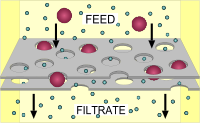
Photo from wikipedia
Abstract We exploit recent results for the multi-mechanism capture of aerosols by an isolated fiber in a steady low-Re crossflow, and analyze the consequences of aerosol polydispersity on the local… Click to show full abstract
Abstract We exploit recent results for the multi-mechanism capture of aerosols by an isolated fiber in a steady low-Re crossflow, and analyze the consequences of aerosol polydispersity on the local particle capture rate per unit volume within a “deep” and spatially uniform fibrous filter medium. The linear first-order PDE governing evolution of the aerosol size distribution (ASD) function, n ( v ; z ) , within such an idealized medium (where v is particle volume and z the axial distance measured into the fibrous filter) is shown to admit exact solutions by a method of successive quadratures, free of restrictive assumptions about the functional form of either the inlet or internal ASD, or the local, multi-mechanism single fiber capture fraction, η cap ( v ) . This solution not only provides access to the usual measure of filter performance—i.e., fraction of the inlet mass (or volume) flow rate which is captured, but enables the accuracy of potentially attractive rational approximate methods to be studied. As examples, when the suspended local ASD is, and remains, single-mode log-normal-like, we formulate and examine the accuracy and efficiency of two tractable, mathematically closed, 3-moment methods for predicting the overall performance of ‘thick’ ( L F / d f ≫ 1 ) non-woven filters comprised of fibers of a single diameter in a uniform ‘matte’ of small solid-fraction, ϕ f . To fix ideas, we illustrate our present theoretical-computational methods, and some of their practical implications, for the particular case of a L F / d f = 300 filter comprised of 2.5 μ m diam. glass fibers challenged by an aerosol population of spherical KCl(s) particles under conditions close to those experimentally studied (and computationally simulated using Brownian-dynamics + CFD methods) in the recent literature. We first consider a ‘coagulation-aged’ aerosol population having an entrance volume fraction of 0.1 × 10 - 6 with d p , g = 200 nm, suspended in a U 0 = 15 cm/s airstream (at p = 1 atm,300 K, Brownian diffusion dominated and interception influenced conditions). To demonstrate the expected improvement in filter efficiency near the previous maximum penetration particle size (MPPS) (ca. 500 nm diam) via the onset of sub-critical particle inertia effects, we also consider a carrier gas velocity of 200 cm/s, revealing a ca. 10-fold gain in local capture efficiency. Such improvements, while offset by the increased penetration of much smaller particles, should be attainable in many fibrous filter applications, provided the associated increase in gas pumping power remains manageable. We conclude with our current assessment of the relative advantages of each of the predictive methods developed and explored here. Tractable generalizations of our essentially deterministic, pseudo-continuum methods—e.g., to enable inclusion of the systematic effects of accessible fiber diameter and orientation distributions also appear to be feasible—as briefly outlined in Section 5.
Journal Title: Separation and Purification Technology
Year Published: 2021
Link to full text (if available)
Share on Social Media: Sign Up to like & get
recommendations!